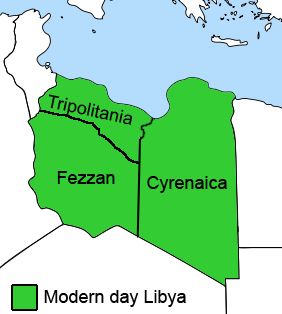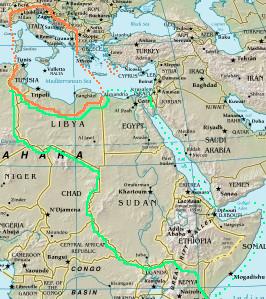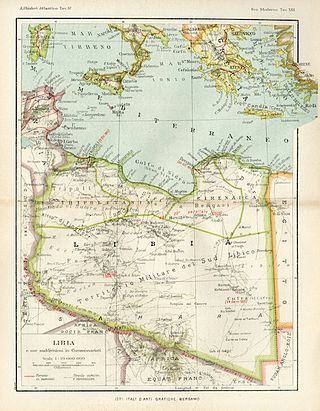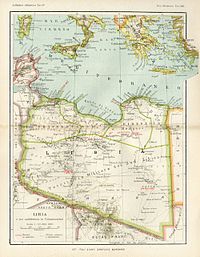History
Libya
One of the initial Italian objectives in Libya had been the relief of overpopulation and unemployment in Italy through emigration to the undeveloped colony. With security established, systematic "demographic colonization" was encouraged by Mussolini's government. A project initiated by Libya's governor, Italo Balbo, brought the first 20,000 settlers, the Ventimili, to Libya in a single convoy in October 1938. More settlers followed in 1939, and by 1940 there were approximately 110,000 Italians in Libya, constituting about 12 percent of the total population. Plans envisioned an Italian colony of 500,000 settlers by the 1960s. Libya's best land was allocated to the settlers to be brought under productive cultivation, primarily in olive groves. Settlement was directed by a state corporation, the Libyan Colonization Society, which undertook land reclamation and the building of model villages and offered a grubstake and credit facilities to the settlers it had sponsored.
The Italians made modern medical care available for the first time in Libya, improved sanitary conditions in the towns, and undertook to replenish the herds and flocks that had been depleted during the war.
Libya was predominantly Italianized in the late 1930s and many Italian colonists moved there to populate Italian North Africa. The Italians in Libya numbered 108,419 at the time of the 1939 census (12.37% of the total population). They were concentrated on the Mediterranean coast around the cities of Tripoli (constituting 37% of the city's population) and Benghazi (31% of the city's population). Libya was made an integral part of Italy in 1939 and the local population were granted a form of Italian citizenship.
In November 1942, Allied forces retook Cyrenaica. By February 1943, the last German and Italian soldiers were driven from Libya and the Allies began occupying Libya.
In the early post-war period, Tripolitania and Cyrenaica remained under British administration, while the French controlled Fezzan. In 1944, Emir Idris returned from exile in Cairo but declined to resume permanent residence in Cyrenaica until the 1947 removal of some aspects of foreign control. Under the terms of the 1947 peace treaty with the Allies, Italy, which hoped to maintain the colony of Tripolitania, (and France, which wanted the Fezzan), relinquished all claims to Libya, which remained united.
Decolonization in Libya fostered an exodus of Italians, especially after Libya became independent in the 1950s. Nearly half of the original Italian colonists who had arrived in 1938 and 1939 left in the late 1940s: [2] this first wave of refugees moved to Italy and soon most of them emigrated in the early 1950s to the Americas (mainly to Canada, Venezuela, Argentina and the United States) and to western Europe (France, Benelux, etc.).
After several years under British mandate, Libya declared its independence in 1951 as the United Kingdom of Libya (a constitutional, hereditary monarchy under King Idris). Most of the remaining Italian colonial settlers, mainly those in areas away from the main cities, left in 1952. Thousands of Italians remained, primarily farmers and craftsmen, and some attempted participation in the political life of the new Libya. [3] [4] King Idris was a relatively tolerant monarch, and generally treated the Italian population well. In 1964 there were still 27,000 Italians in Libya, of which 24,000 were living in the metropolitan area of Tripoli.
Tunisia
A large community of Italian Tunisians in the French protectorate of Tunisia gained critical economic and social weight in the first half of the 19th century. During the 1920s, Italian fascism initially promoted only the defense of the national and social rights of the Italians in French Tunisia against the attempts at amalgamation made by France. [5] Mussolini opened some Italian banks in Tunisia such as the Banca Siciliana, Italian newspapers such as L'Unione, and some Italian theaters, cinemas, schools (primary and secondary), and health assistance organizations and hospitals.
In the 1926 census of French Tunisia there were 173,281 Europeans, of which 89,216 were Italians, 71,020 French and 8,396 Maltese. [6] Regarding this relative majority, Laura Davi wrote in his 1936 Memoires italiennes en Tunisie that "Tunisia is an Italian colony administered by French managers".
However in the late 1930s the ideals of Italian irredentism, the unification of all ethnically Italian peoples, started to appear amongst the Tunisian Italians. As a consequence, mainly after 1938, fascism promoted a moderate form of Italian irredentism for the Italians of Tunisia, based on their right to remain Italians. [7] The fascist party of Tunisia actively recruited volunteers for wars in Spain, Ethiopia, and other places. They also began promoting the idea of the Fourth Shore, aiming to legitimize wresting Tunisia from French control.
Tunisia was conquered by Italy in November 1942, and due to its large Italian community, it was added to the Fourth Shore. [8] In the first months of 1943 Italian schools were opened in Tunis and Biserta, while 4000 Italian Tunisians volunteered for the Italian Army. [9] Some Italian newspapers and magazines that had been closed by the French government in the late 1930s were reopened. [10] Many Tunisian Arabs and Berbers wanted Tunisia to unite with Italy. [11]
From December 1942 until February 1943 Tunisia and Libya were under Italian control and administered as Italian North Africa, [12] but later the Allies conquered Tripolitania and Italian control was reduced to the Tunisian area west of the Mareth Line (where an Axis last stand was fought).
In May 1943, the Allies completed their Tunisian campaign and regained all Tunisian territory for France. The French colonial authorities then closed all Italian schools and newspapers. [11] Resident Italians with suspected Axis loyalties were surveilled by the French. The Tunisian Italian community began to dissipate. The disappearance was escalated during the process of Tunisian independence from France (1952–1956). [13]
In the 1946 census the Italians in French Tunisia numbered 84,935, in 1959 there were 51,702, and in 1969 less than 10,000 remained in independent Tunisia. In 2005 there were only 900 Tunisian Italian residents, mainly concentrated in the Tunis metropolitan area.

Cyrenaica or Kyrenaika, is the eastern region of Libya. Cyrenaica includes all of the eastern part of Libya between the 16th and 25th meridians east, including the Kufra District. The coastal region, also known as Pentapolis in antiquity, was part of the Roman province of Crete and Cyrenaica, later divided into Libya Pentapolis and Libya Sicca. During the Islamic period, the area came to be known as Barqa, after the city of Barca.

Muhammad Idris bin Muhammad al-Mahdi as-Senussi was a Libyan political and religious leader who was King of Libya from 24 December 1951 until his ouster in the 1 September 1969 coup d'état. He ruled over the United Kingdom of Libya from 1951 to 1963, after which the country became known as simply the Kingdom of Libya. Idris had served as Emir of Cyrenaica and Tripolitania from the 1920s until 1951. He was the chief of the Senussi Muslim order.

Tripolitania, historically known as the Tripoli region, is a historic region and former province of Libya.

Subdivisions of Libya have varied significantly over the last two centuries. Initially Libya under Ottoman and Italian control was organized into three to four provinces, then into three governorates (muhafazah) and after World War II into twenty-five districts (baladiyah). Successively into thirty-two districts (shabiyat) with three administrative regions, and then into twenty-two districts (shabiyat). In 2012 the ruling General National Congress divided the country into governorates (muhafazat) and districts (baladiyat). While the districts have been created, the governorates have not.

The Provinces of Libya were prescribed in 1934, during the last period of colonial Italian Libya, and continued through post-independence Libya until 1963 when the Governorates system was instituted.

The Italian colonizationof Libya began in 1911 and it lasted until 1943. The country, which was previously an Ottoman possession, was occupied by Italy in 1911 after the Italo-Turkish War, which resulted in the establishment of two colonies: Italian Tripolitania and Italian Cyrenaica. In 1934, the two colonies were merged into one colony which was named the colony of Italian Libya. In 1937, this colony was divided into four provinces, and in 1939, the coastal provinces became a part of metropolitan Italy as the Fourth Shore. The colonization lasted until Libya's occupation by Allied forces in 1943, but it was not until the 1947 Paris Peace Treaty that Italy officially renounced all of its claims to Libya's territory.

This is a survey of the postage stamps and postal history of Tripolitania, now part of Libya.

The military history of Libya covers the period from the ancient era to the modern age.

Libya was a colony of Fascist Italy located in North Africa, in what is now modern Libya, between 1934 and 1943. It was formed from the unification of the colonies of Cyrenaica and Tripolitania, which had been Italian possessions since 1911.

Imperialism, colonialism and irredentism played an important role in the foreign policy of Fascist Italy. Among the regime's goals were the acquisition of territory considered historically Italian in France and Yugoslavia, the expansion of Italy's sphere of influence into the Balkans and the acquisition of more colonies in Africa. The pacification of Libya (1923–32), the invasion of Ethiopia (1935–36), the invasion of Albania (1939), the invasion of France (1940), the invasion of Greece (1940–41) and the invasion of Yugoslavia (1941) were all undertaken in part to add to Italy's national space. According to historian Patrick Bernhard, Fascist Italian imperialism under Benito Mussolini, particularly in Africa, served as a model for the much more famous expansionism of Nazi Germany in Eastern Europe.

Italian Tripolitania was an Italian colony, located in present-day western Libya, that existed from 1911 to 1934. It was part of the territory conquered from the Ottoman Empire after the Italo-Turkish War in 1911. Italian Tripolitania included the western northern half of Libya, with Tripoli as its main city. In 1934, it was unified with Italian Cyrenaica in the colony of Italian Libya. In 1939, Tripolitania was considered a part of the Kingdom of Italy's 4th Shore.

Italian Cyrenaica was an Italian colony, located in present-day eastern Libya, that existed from 1911 to 1934. It was part of the territory conquered from the Ottoman Empire during the Italo-Turkish War of 1911, alongside Italian Tripolitania.

Italian Libyans are Libyan-born citizens who are fully or partially of Italian descent, whose ancestors were Italians who emigrated to Libya during the Italian diaspora, or Italian-born people in Libya. Most of the Italians moved to Libya during the Italian colonial period.

The Libyan Coastal Highway, formerly the Litoranea Balbo, is a highway that is the only major road that runs along the entire east-west length of the Libyan Mediterranean coastline. It is a section in the Cairo–Dakar Highway #1 in the Trans-African Highway system of the African Union, Arab Maghreb Union and others.

This is a survey of the postage stamps and postal history of Libya. Libya is a country located in North Africa. Bordering the Mediterranean Sea to the north, Libya lies between Egypt to the east, Sudan to the southeast, Chad and Niger to the south, and Algeria and Tunisia to the west.

Tripoli Province was one of the provinces of Libya under Italian rule. It was established in 1937, with the official name: Commissariato Generale Provinciale di Tripoli. It lasted until 1947.

The Allied administration of Libya was the control of the ex-colony of Italian Libya by the Allies from 13 May 1943 until Libyan independence was granted in 1951. It was divided into two parts:

The British Military Administration of Libya was the control of the regions of Cyrenaica and Tripolitania of the former Italian Libya by the British from 1943 until Libyan independence in 1951. It was part of the Allied administration of Libya.

The Southern Military Territory was a jurisdictional territory within the Italian colonies of Cyrenaica and Tripolitania (1911-1934) and later Italian Libya (1934–1947), administered by the Italian military in the Libyan Sahara.

The Second Italo-Senussi War, also referred to as the Pacification of Libya, was a conflict that occurred during the Italian colonization of Libya between Italian military forces and indigenous rebels associated with the Senussi Order. The war lasted from 1923 until 1932, when the principal Senussi leader, Omar al-Mukhtar, was captured and executed. The Libyan genocide took place during and after the conflict.
















